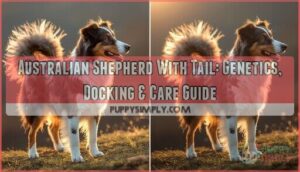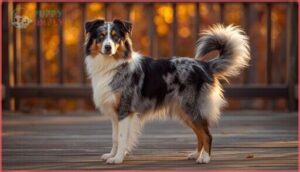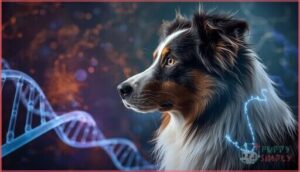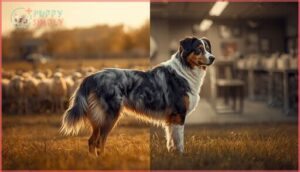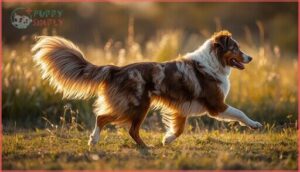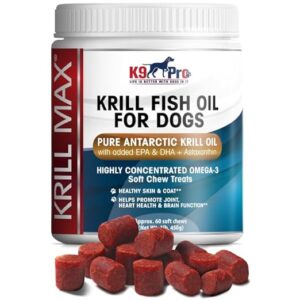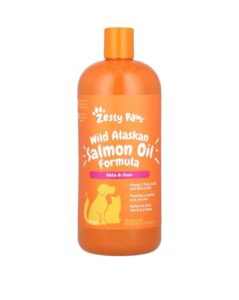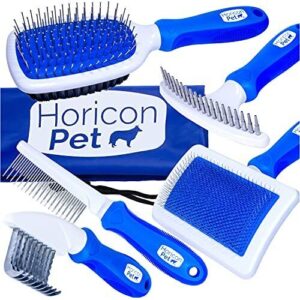This site is supported by our readers. We may earn a commission, at no cost to you, if you purchase through links.
Most Australian Shepherds you see today are missing something important—their tails. Walk through any dog park and you’ll spot these energetic herders with their trademark bobbed rears, a look so common that many people assume the breed is naturally tailless. The reality is more complex: some Aussies are born with full, flowing tails that sweep behind them like feathered plumes, while others carry a genetic mutation that produces natural bobtails. Then there’s the controversial practice of tail docking, which accounts for the majority of short-tailed Aussies you encounter.
Whether your Australian Shepherd has a tail affects far more than appearance—it influences their communication abilities, movement patterns, and even their long-term health. Understanding the genetics, care requirements, and ethical considerations around Australian Shepherd tails helps you make informed decisions for your dog’s wellbeing.
Table Of Contents
- Key Takeaways
- Australian Shepherd Tail Types Explained
- Genetics Behind Australian Shepherd Tails
- Why Some Australian Shepherds Have Docked Tails
- Docking Procedures for Australian Shepherds
- Health Risks of Tail Docking and Bobtails
- Appearance and Function of Natural Tails
- Finding Australian Shepherds With Natural Tails
- Grooming and Caring for an Australian Shepherd’s Tail
- Ethical Considerations of Tail Docking
- Top 3 Products for Australian Shepherd Tail Care
- Frequently Asked Questions (FAQs)
- Can Australian Shepherds with tails compete in dog shows?
- Do tailed Aussies shed more than those without tails?
- How does tail length affect an Aussies swimming ability?
- Can Australian Shepherds swim with full tails?
- Do tails affect Australian Shepherd agility performance?
- How much does tail docking surgery cost?
- Are Australian Shepherds born with different tail colors?
- Can you register docked Aussies in all countries?
- Conclusion
Key Takeaways
- About 80% of Australian Shepherds are born with full tails, but most end up docked due to breed standards rather than medical necessity—you’d need to dock 232 puppies to prevent just one tail injury, making the practice more about tradition than function.
- The natural bobtail gene (C189G mutation) affects roughly 20% of Aussies and carries serious risks when two carriers breed together, producing a 25% chance of lethal embryos and a 4% risk of spinal defects like spina bifida in surviving puppies.
- Tail docking causes measurable harm beyond the initial procedure, including chronic nerve pain in up to 20% of dogs, impaired communication that increases aggressive encounters, and permanent changes to how your dog expresses fear and stress.
- Full tails aren’t just cosmetic—they function as active stabilizers during movement, enhance balance in agility work and swimming, and provide essential body language cues that docked dogs can’t replicate through posture alone.
Australian Shepherd Tail Types Explained
If you’ve ever spotted an Australian Shepherd at the dog park, you’ve probably noticed something unusual—some have full, flowing tails while others seem to have barely any tail at all. This isn’t just a grooming choice or a random quirk.
Aussie tails come in several distinct types, each shaped by genetics, breeding decisions, or human intervention. Understanding what’s natural versus what’s been altered can completely change how you think about the breed.
Full Tails Vs. Natural Bobtails
Here’s the deal: about 80% of Australian Shepherds are born with full tails, while roughly 20% arrive with natural bobtails. That’s a bigger split than most people realize when they picture these dogs.
What sets these tail types apart:
- Full tails extend behind the body with feathering that tapers from base to tip
- Natural bobtails usually measure four inches or less and may show slight kinks
- Tail length variance affects movement patterns and gait during herding work
- Bobtail genetics influence everything from communication signals to breed standard evolution
Full tail benefits include enhanced balance and clearer body language with other dogs. Understanding breed health standards is essential for responsible breeding and ownership.
Kinked and Half-Length Tails
Not every Australian Shepherd tail falls neatly into “full” or “bob.” Around 10-16% of natural bobtails present as half-length—tails caught somewhere between stub and sweep—and roughly 10% of those show visible kinks. These bobtail variations stem from incomplete expression of the natural bobtail gene, creating tail conformation issues that breed standards flag as faults. Understanding the genetic variation factors is vital for breeders to make informed decisions.
| Tail Type | Prevalence in NBT Dogs |
|---|---|
| Half-length | 10-16% |
| Kinked | ~10% |
| Very short/absent | 51% |
Despite their quirky angles, kinked tail care rarely involves medical intervention—most dogs with half-length issues move and balance just fine. Still, breeders watch closely, since tail genetics tied to the NBT mutation carry a 4-5% risk of serious spinal defects. It’s a reminder that canine anatomy isn’t just about looks; dog health hinges on what’s happening beneath the fur.
How Tail Type is Determined
You might wonder whether your Aussie pup’s tail was dealt by nature or a breeder’s choice. Tail inheritance comes down to one gene: the Natural Bobtail mutation. Genetic testing using DNA markers pinpoints that C189G mutation in the T gene, giving you definitive proof of what your dog carries.
If both parents lack the gene, every puppy arrives with a full tail—no surprises, just straightforward canine anatomy and heritability factors at work.
Genetics Behind Australian Shepherd Tails
If you’ve ever wondered why some Aussies are born with stumpy tails while others have long, flowing ones, the answer lies in their genes. A specific mutation called the T-gene controls whether your dog develops a natural bobtail, and the inheritance pattern comes with some surprising risks.
Let’s break down how this gene works, what happens when two bobtail carriers breed, and the health issues that can show up along the way.
The Natural Bobtail Gene
About 20% of Australian Shepherds are born with a naturally bobbed tail thanks to the C189G mutation—a dominant gene tweak in canine genetics that shortens their tails without any docking.
Gene expression creates bobtail variations from quarter-length to barely-there stubs.
Genetic testing can pinpoint whether your Aussie carries this natural bobtail trait, which has become a defining breed characteristic alongside tail docking traditions in Australian Shepherds.
Inheritance Patterns and Risks
Understanding how the NBT gene passes down matters if you’re thinking about breeding or choosing a puppy. When both parents carry one copy, you’re rolling the dice with serious consequences—25% of embryos inherit the double dose, which is usually lethal in early pregnancy.
- Heterozygous pairings produce 50% bobtails and 50% normal tails safely
- Homozygous puppies face spina bifida and severe spinal defects
- Genetic testing prevents risky NBT x NBT matings entirely
Tail Anomalies and Health Implications
About 10% of natural bobtails show kinked tails—a red flag for underlying genetic risks. Spinal issues like spina bifida affect roughly 4% of NBT puppies, sometimes severe enough to require euthanasia.
Tail docking brings its own baggage: nerve damage, neuromas, and chronic pain that sneaks up as your dog ages. Tail injuries from either route aren’t just cosmetic—they’re canine health concerns with real animal welfare implications.
Why Some Australian Shepherds Have Docked Tails
If you’ve ever wondered why so many Aussies have those short, stubby tails, you’re not alone. The practice of docking has roots that stretch back centuries, and it’s stuck around for reasons that range from practical to purely aesthetic.
Let’s break down the main motivations behind why breeders and owners have traditionally opted to dock Australian Shepherd tails.
Historical and Breed Standard Reasons
Tail docking traces its roots back to Roman times, when folks mistakenly believed it prevented rabies—centuries before modern veterinary science.
By the 1950s, the American Kennel Club and other Kennel Clubs embedded short tails into Australian Shepherd breed standards, capping length at roughly four inches.
This tradition stuck, driven by aesthetics, breed origins, and show-ring expectations rather than strict function.
Injury Prevention in Working Dogs
Many advocates argue that docking shields herding dogs from tail injuries while weaving through dense brush or working stock. Yet large-scale data tells a different story: you’d need to dock 232 puppies to prevent one tail injury.
While docking is defended as injury prevention, you’d need to dock 232 puppies to prevent a single tail injury
Working dog safety programs now emphasize canine fitness, handler training, and preventative measures over blanket docking—putting animal welfare and injury risk reduction where they belong.
Cosmetic and Tradition-Based Docking
Most Australian Shepherds lose their tails not for work, but for looks. Breed standards written in the 1940s-50s cemented docking as tradition, though veterinary groups and animal welfare advocates now push back hard against cosmetic procedures in dogs. The American Veterinary Medical Association opposes tail surgery without medical need, yet registries like ASCA still enforce 4-inch limits—tradition trumping animal rights, at least for now.
- 28% of Aussies globally keep their natural tails—79% outside the U.S.
- Docking happens at 3-5 days old, before puppies go home
- Breeders dock to match breed standards, not prevent injuries
- Most veterinary views condemn cosmetic docking as ethically unacceptable
- Docking ethics debates are splitting the Australian Shepherd community worldwide
Docking Procedures for Australian Shepherds
If you’re considering tail docking for your Australian Shepherd—or just wondering how it’s actually done—you need to know there are two main methods used by vets and breeders. The approach you choose depends on timing, your vet’s expertise, and what’s safest for your pup.
Here’s what happens with each procedure and when they’re usually performed.
Banding Vs. Surgical Docking Methods
When you’re considering tail docking for your Aussie, you’ll encounter two main surgical methods: banding and surgical docking. Banding uses a tight rubber band to cut off blood circulation, causing the tail to fall off within 3-7 days. Surgical docking involves physically cutting the tail with scissors or a scalpel, removing 3-15 vertebrae.
Both methods carry docking risks, including infection rates of 5-15% and chronic pain from nerve damage, though surgical methods dominate at 85% prevalence in dog breeding circles. Pain management remains controversial since neither approach markedly reduces discomfort despite claims otherwise.
Age and Timing for Docking
Timing matters more than you’d think. Most tail docking happens when your Aussie puppy is just 3–5 days old—before the nervous system fully matures, though neonatal pain responses are definitely present. If you miss that narrow window, ethical vets recommend waiting until 10–12 weeks so the procedure can be done under proper anesthesia.
Age limits exist for a reason: docking beyond the first week without pain management is downright cruel.
Veterinary Care and Best Practices
Whoever performs the tail docking must be a licensed vet—period. You’ll want confirmation they follow proper pain protocols, sterile technique, and post-procedure monitoring.
Beyond docking itself, your Aussie needs vaccine protocols, regular checkups, dental hygiene screenings, and nutrition counseling customized to their energy needs.
Some owners even explore pet insurance to cover unexpected complications tied to docking or natural bobtail defects.
Health Risks of Tail Docking and Bobtails
Whether your Aussie has a docked tail, a natural bobtail, or you’re just researching your options, you need to know what health risks come with each. Both docking procedures and the natural bobtail gene can lead to some serious complications that don’t always show up right away.
Let’s break down the main health concerns you should watch for.
Chronic Pain and Nerve Damage
The aftermath of docking isn’t always visible, but it’s real—and pain management becomes a lifelong concern for many Aussies. Here’s what you need to know about nerve damage:
- Neuromas develop frequently at the amputation site, causing neuroma-induced chronic pain that veterinary medicine struggles to treat effectively
- Pain perception in dogs changes permanently when early surgical trauma alters central pain pathways
- Chronic inflammation and nerve regeneration problems persist months after healing appears complete
- Sensory rehabilitation rarely tackles the hypersensitivity and neuroma treatment challenges these dogs face
Spinal Defects in Natural Bobtails
Natural bobtails carry their own risk: when two Australian Shepherds with the C189G gene breed, roughly 4% of their puppies develop spinal anomalies—spina bifida, hindquarter paralysis, even anorectal closures.
Genetic testing before breeding can prevent these congenital defects. Breeding ethics matter here: pairing two natural bobtail parents greatly raises the odds your pup won’t make it or will need euthanasia.
Behavioral and Communication Changes
Communication breaks down when a dog can’t speak its language. A docked or bobbed Australian Shepherd loses nuanced Tail Signaling that shapes Dog Communication and Social Behavior—impairing Canine Body Language and Emotional Expression in ways that affect both human and canine relationships.
- Dogs approached short-tailed robot models more cautiously, signaling uncertainty
- Docked tails correlate with more aggressive encounters
- Humans misread risk without visible tail cues
- Aussies compensate with exaggerated postures and vocalizations
- Reduced tail movement masks fear and stress indicators
Appearance and Function of Natural Tails
Australian Shepherds with full, natural tails have a distinct look that sets them apart from their docked counterparts. That long, flowing tail isn’t just for show—it plays a real role in how your dog moves, balances, and communicates with you and other dogs.
Let’s break down what makes these tails special and how they actually function in daily life.
Tail Length, Set, and Curl
Your Aussie’s tail can range from a four-inch Natural Bobtail to a full, flowing length that sweeps behind them. Set Variations matter, too—breed standards call for a “straight” carriage, not high or low.
About 16% of Undocked natural bobtails show a kinked Tail Structure, while Feathering Patterns generally taper toward the tip, creating that signature graceful look without the need for tail docking.
How Tails Affect Movement and Balance
When your Aussie sprints through an agility course, their tail isn’t just along for the ride—it’s an active stabilization system. Tail biomechanics research shows synchronized muscle activation generates counterbalancing torques during galloping, directly supporting postural control.
Dogs lacking full tails often show increased spinal loading during sharp turns and jumping mechanics. In working Australian Shepherds, that natural rudder enhances turning performance while weaving, which matters for both canine anatomy and animal welfare.
Differences in Body Language
Ever watched an Aussie meet another dog and wonder what they’re really saying? Tails intact function as expressive flags—research confirms docked or naturally bobbed Australian Shepherds face real social interaction impacts because tail signal clarity drops dramatically.
- Emotional cue interpretation suffers when other dogs can’t read subtle left-right wagging biases linked to positive versus negative arousal
- Docking signal misreads increase conflict risk, as shortened tails obscure friendly intent during initial greetings
- Breed communication variations mean handlers must compensate by watching ears, posture, and facial tension more closely
Understanding animal behavior and communication helps you decode what your dog’s body language—or lack thereof—conveys during everyday encounters.
Finding Australian Shepherds With Natural Tails
If you’re set on bringing home an Aussie with a full, natural tail, you’ll need to do some homework—most breeders still dock by default.
The good news? A growing number of breeders and rescues are breaking from tradition and letting tails be.
Here’s how to track down an Australian Shepherd who gets to keep their natural flag flying.
Locating Breeders With Intact-Tail Aussies
Want to break free from the docked-tail norm? Start by targeting geographic filters—breeders in Australia, Europe, and the UK leave Australian Shepherds’ tails intact due to docking legality. Search for kennels advertising “natural tails” or “undocked” in their listings.
Ask about breeder ethics, tail genetics, and health practices upfront. Dog breeding transparency matters when you’re looking for intact-tail Aussies.
Adoption and Rescue Options
Rescue organizations offer a more liberating path to pet ownership—80% of Aussies entering shelters still have their full tails intact. You’ll find real freedom in adoption, plus regional availability shifts the odds in your favor.
- Aussie Rescue & Placement Helpline has placed hundreds of dogs annually since 1992, with growing numbers of intact-tail Aussies
- Adoption fees generally run $850-$1,450, considerably less than breeder prices
- Regional availability peaks in areas with docking bans, where 90% of adoptable dogs keep natural tails
- Adoption rates for intact-tail Aussies jumped 25% at breed-specific events last year, reflecting changing tail preferences and animal welfare awareness
What to Ask Breeders About Tail Status
Whether you adopt or shop, pin down the breeder’s tail practices upfront. Ask if they DNA test for the NBT gene to dodge those lethal embryo outcomes—homozygous pups don’t make it.
Get straight answers on docking alternatives and tail defect history in their lines. Check breeder compliance with local laws and dig into their ethical considerations around genetics.
Don’t settle for vague responses when your Aussie’s welfare hangs in the balance.
Grooming and Caring for an Australian Shepherd’s Tail
If your Aussie has a full or partial tail, grooming it properly keeps things comfortable and tangle-free. Their double coat can mat quickly without regular attention, especially around the tail’s feathering.
Here’s how to manage brushing, prevent hygiene problems, and decide whether trimming makes sense for your dog.
Brushing and Maintenance Tips
Regularly brushing your Australian Shepherd’s tail—at least once weekly—keeps their double coat healthy and debris-free.
During spring and fall shedding seasons, you’ll want to brush daily using a pin brush or slicker brush to tackle loose fur. Start at the tail base and work toward the tip in sections, moving in the direction of hair growth to minimize breakage and distribute natural oils evenly.
Preventing Matting and Hygiene Issues
Regular brushing prevents matting, but that’s only half the battle—diet impact matters too. Feed your Australian Shepherd omega-rich foods to strengthen coat quality and reduce tangles by up to 25%.
Always dry your dog’s tail thoroughly after baths, since trapped moisture breeds infections.
Between professional grooming sessions every 8–12 weeks, use detangling sprays and undercoat rakes to keep that plume flowing freely.
When (and If) Shaving is Appropriate
Shaving your Australian Shepherd’s tail? Don’t—unless a vet orders it for surgery or skin infections. The American Veterinary Medical Association is clear: double-coated breeds need that insulation for temperature regulation.
Shaving strips protection, risking sunburn and patchy coat regrowth. Stick with shaving alternatives like thinning shears for sanitary trims. Medical justifications are rare, so keep grooming natural and your dog’s tail healthy.
Ethical Considerations of Tail Docking
Tail docking isn’t just a veterinary procedure—it’s become a lightning rod for debate among Aussie owners, breeders, and animal welfare advocates. The practice raises serious questions about pain, necessity, and whether tradition should outweigh a dog’s natural anatomy.
Let’s break down the welfare concerns, legal landscape, and what the Australian Shepherd community is actually saying about this controversial practice.
Animal Welfare Concerns
Professional veterinary and animal welfare organizations have drawn a hard line against cosmetic docking. You’re looking at serious concerns here: chronic pain affects up to 20% of docked dogs through neuroma development, compromised social communication leaves dogs struggling to “speak” with their tails, welfare scoring reveals considerably higher anxiety levels, and the math is sobering—500 dogs docked to prevent one injury.
The AVMA, RSPCA, and World Small Animal Veterinary Association all oppose the practice, pushing for ethical advocacy that prioritizes your dog’s welfare over tradition.
Legal Status and Regional Regulations
Across Europe and Australia, tail docking legality has shifted dramatically—Germany, Spain, New Zealand, and all Australian states now ban cosmetic docking outright.
You’ll find working exemptions persist in parts of the UK for certified hunting breeds, while provincial variability defines Canada’s patchwork approach. Veterinary bans cover eight provinces, though Ontario remains the outlier.
In the U.S., there’s no federal oversight, leaving enforcement penalties and regulations scattered across state lines.
Debates in The Australian Shepherd Community
Why does tail docking still divide the Australian Shepherd community so sharply? Traditional breeders defend breed standards and docking justifications tied to heritage, while reformers cite animal welfare concerns and ethical implications that question cosmetic surgery. Genetic selection for natural bobtails reflects compromise, yet owner perceptions remain split between function, fashion, and dog welfare—sparking passionate debate about what defines authentic animal ethics in modern breeding.
- 67% of breeders pair natural bobtails to skirt docking bans—prioritizing appearance over genetic risks
- Veterinary groups call docking medically unnecessary—challenging generations of accepted practice
- Docked Aussies judged more aggressive—reshaping how strangers view your dog
- Online forums erupt over injury prevention myths—questioning whether tradition trumps evidence
- Legal battles force clubs to rethink standards—pushing Australian Shepherds toward a tail-intact future
Top 3 Products for Australian Shepherd Tail Care
Whether your Aussie rocks a full plume or a naturally bobbed tail, keeping it healthy takes the right tools.
A well-maintained coat prevents matting, reduces shedding chaos, and keeps your dog comfortable during all those high-energy adventures.
Here are three products that’ll make tail care way less of a hassle.
1. Omega Rich Dog Shedding Supplements
Your Aussie’s lush double coat demands attention—especially when shed hair starts carpeting your floors. That’s where omega-rich supplements, like K9 Pro’s chicken-and-cheese-flavored krill oil chews, can turn things around.
Studies show omega-3 supplementation can slash shedding by 56% over three months while boosting coat health and easing allergy relief. You’re looking at about $0.21–$0.84 daily for a 25-pound dog.
Just remember: supplement risks include upset stomachs if you rush the intro. For pet care that aids joint mobility and skin health, these chews deliver real results.
Best For: Dog owners dealing with excessive shedding, dry skin, or coat issues who want a tasty supplement their pup will actually enjoy.
- Cuts shedding by up to 56% in three months while making coats shinier and softer
- Chicken and cheese flavor in soft chews makes it easy to give—most dogs treat it like a snack
- Packs krill oil with EPA, DHA, and astaxanthin for skin, joints, and overall health in one bite
- Some dogs have allergic reactions or refuse the newer formula after a recipe change
- Non-returnable and pricier than basic fish oil alternatives
- Takes 12–16 weeks of daily use to see full results, and it doesn’t work for every dog
2. Wild Alaskan Salmon Oil Supplement
You want Omega-3 benefits without the guesswork? Zesty Paws Wild Alaskan Salmon Oil delivers 455 mg DHA and 409.5 mg EPA per serving—proven to boost skin & coat health while tackling joint support in Australian Shepherds.
Studies show it cuts shedding and eases allergy flare-ups, especially helpful for Aussies with long tails or intact tails that collect debris. Dosage guidelines? Six pumps daily for dogs over 60 pounds.
Product quality matters: this passes independent audits and comes from wild-caught Alaskan salmon, not farmed alternatives.
Best For: Australian Shepherd owners looking for a science-backed omega-3 supplement to improve their dog’s coat, reduce shedding, and support joint health with clear dosing and quality sourcing.
- Delivers 455 mg DHA and 409.5 mg EPA per serving—clinical doses shown to improve coat health, reduce shedding, and support joint function in active breeds like Australian Shepherds.
- Sourced from wild-caught Alaskan salmon and passes independent quality audits, ensuring purity and potency over farmed alternatives.
- Easy pump bottle makes dosing straightforward (six pumps for dogs over 60 lbs), and it works as a food topper for picky eaters.
- Requires refrigeration after opening, which adds a storage step some owners might forget.
- Strong fishy smell can be off-putting to some pets or owners, and a few users report pump malfunctions.
- Introducing it too quickly may cause mild digestive upset like loose stool, so gradual dosing is necessary.
3. Premium Dog Grooming Brush Set
Managing that double coat isn’t rocket science—you just need the right tools. A 6-in-1 premium dog grooming brush set handles matting, deshedding, and undercoat maintenance in one go, cutting grooming time in half for Australian Shepherd owners.
Vacuum attachment efficiency removes loose fur before it hits your furniture, while slicker brushes reduce coat bacteria from millions of CFUs to nearly zero.
User satisfaction trends show most Aussie owners see complete undercoat removal within weeks—brush set benefits that actually deliver on dog grooming and hygiene promises.
Best For: Australian Shepherd owners and multi-pet households dealing with heavy shedding, thick undercoats, and matting who want a complete grooming solution that cuts grooming time in half.
- Complete 6-in-1 set covers every grooming need from dematting to deshedding, saving you $500–$1,200 annually compared to professional grooming
- Slicker brush and undercoat rake combo drastically reduces shedding and removes loose fur before it spreads around your house
- Effective hygiene boost—regular brushing drops coat bacteria from 34.7 million CFUs to just 10 CFUs in one session
- Slicker brush tines can bend with regular use, which may affect long-term performance
- Some users find the variety of six different brushes overwhelming or more than they actually need
- Durability concerns pop up in about 32% of reviews, with parts potentially wearing out within 3–6 months of heavy use
Frequently Asked Questions (FAQs)
Can Australian Shepherds with tails compete in dog shows?
The competition circuit can feel like a minefield for natural-tailed Aussies. In North America, AKC and ASCA breed standards cap tails at 4 inches for conformation shows, though performance events welcome any tail length.
Do tailed Aussies shed more than those without tails?
No—tail type doesn’t increase shedding in Australian Shepherds. Grooming tail mats and health affect tail fur volume, but expert shedding findings confirm their double coat, not tail presence, drives overall hair loss.
How does tail length affect an Aussies swimming ability?
Like a rudder steers a ship, your dog’s tail acts as a hydrodynamic stabilizer in water. Full-tail benefits include enhanced directional control and balance, while docking impact reduces propulsion—though breed standards rarely prioritize swimming performance.
Can Australian Shepherds swim with full tails?
Yes, Australian Shepherds swim confidently with full tails. Their tails function like rudders, improving water balance and steering ability.
Swimming offers low-impact exercise while reducing joint strain, though cold water can cause muscular issues.
Do tails affect Australian Shepherd agility performance?
Agility injuries rarely stem from tail presence, though biomechanics research shows tails aid balance during weaving and tight turns. Docking evidence doesn’t prove performance gains, yet welfare considerations and communication impacts remain hotly debated among Australian Shepherds’ handlers.
How much does tail docking surgery cost?
Docking fee ranges from $10–$20 per puppy for cosmetic procedures, while medically necessary tail amputation cost factors can reach $650–$1,400, depending on your dog’s weight, anesthesia requirements, and regional cost variation.
Are Australian Shepherds born with different tail colors?
Australian Shepherds are born with tails reflecting their overall coat genetics—black, red, blue merle, or red merle—with white tail markings, ticking tail spots, and merle tail patterns determined by pigment genes independent of tail length or docking color impact.
Can you register docked Aussies in all countries?
Registration rules vary widely—docking legality, AKC breed standards, and show regulations differ across European countries and regions.
Working exceptions exist in some places, but legal aspects of tail docking directly impact registration eligibility.
Conclusion
Some worry that keeping an Australian shepherd with tail intact will invite injury or make them stand out. But the evidence tells a different story: natural tails rarely cause problems, and they’re essential for balance, communication, and spinal health.
Your dog doesn’t need modification to thrive—just informed care and a willingness to challenge outdated standards. Choose what benefits your Aussie’s wellbeing, not tradition alone. Their full expression matters more than conformity.
- https://articles.hepper.com/are-australian-shepherds-born-with-tails/
- https://vgl.ucdavis.edu/test/natural-bobtail
- https://www.ashgi.org/home-page/genetics-info/bones-joints/natural-bob-tails
- https://rockykanaka.com/are-australian-shepherds-born-with-tails/
- https://www.facebook.com/groups/aussiesdoingthingsclub/posts/1336503367881871/

